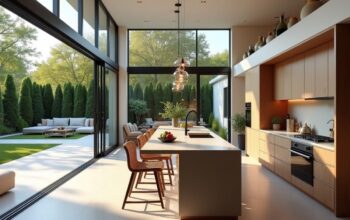How to Build Energy-Efficient Homes
Whether you’re building a new home or renovating the old one, you want to ensure it’s energy efficient. That means having all the right equipment and ensuring it’s installed correctly.
Insulation
Adding insulation to your home is a cost-effective way to reduce energy costs. It also helps you create a greener, more comfortable living environment.
There are many types of insulation materials to choose from. Each variety is designed for different applications and may be used in several ways.
Fiberglass is the most common type of insulation used in homes. It is a non-combustible material that doesn’t shrink. It is used in attics. However, it loses R-value over time.
If you want to upgrade your insulation, check the recommended R-values for each area. A Home Energy Saver tool can help you determine the R-values you need to maximize your insulation.
When upgrading your insulation, consider the areas where you can quickly seal air leaks. Sealing air leaks can save you 15% on your heating and cooling bills. If you’re remodeling your home, spray foam can seal any gaps. The spray foam expands into a solid foam that seals the wall cavities.
Proper site orientation
Whether planning to build a new home or renovate an existing structure, choosing the right site orientation can reduce energy bills and preserve your home’s appeal. In addition, the site’s orientation can influence natural lighting, views, and feng shui.
An ideal orientation will have a balance between the sun, breezes, and other factors. It should also allow maximum ventilation in all seasons. In addition, it should be able to take advantage of the sun’s energy for cooling and heating.
An ideal orientation receives the most sunlight in the winter and the least in the summer. However, you can have a different angle to get good performance. Even a deviation of up to 30 degrees east and west of the ideal can achieve reasonable sun control.
The best orientation for a house is one that has at least a few windows that face north. These windows will help to reduce your energy usage.
Off-grid design
Whether you’re considering building an off-grid home or simply increasing your current home’s energy efficiency, you should consider several essential factors. These include the climate and location of the home, as well as the design of the home and the materials used.
Your Home Wichita architects and contractors can assist you in making the most use of electric appliances in your house. They can also provide you with guidance on heating and cooling set points.
A good off-grid home is built with thick insulation. It conserves the heat from the sun in the winter. However, it should be remembered that solar panels generate less power during the winter months. To compensate, consider building a cistern to store rainwater. You can also add solar panels to boost efficiency.
Many off-grid homes are designed to use solar photovoltaic panels. It is the most common off-grid energy source. You will need an inverter to convert the solar power into usable electricity.
Smart devices
Using intelligent devices to build energy-efficient homes is a smart way to save money and protect the environment. It also makes life more convenient. You can monitor your home for health and security issues with innovative technology. You can even control your appliances remotely.
Currently, the majority of American households have at least one smart device. These are devices that interact with other appliances and the Internet. They use algorithms, sensors, and data to control their functions. These digital assistants can turn on music, search the Internet, and delegate tasks.
A smart thermostat can learn a user’s habits to adjust its temperature automatically. These devices are much less energy-consuming than traditional ones. They can also alert users when there is a water leak in the house. It helps to prevent damage to water pipes.
Another excellent example of an intelligent device is a bright power strip. It reduces electricity usage by controlling the amount of energy used by each appliance.




